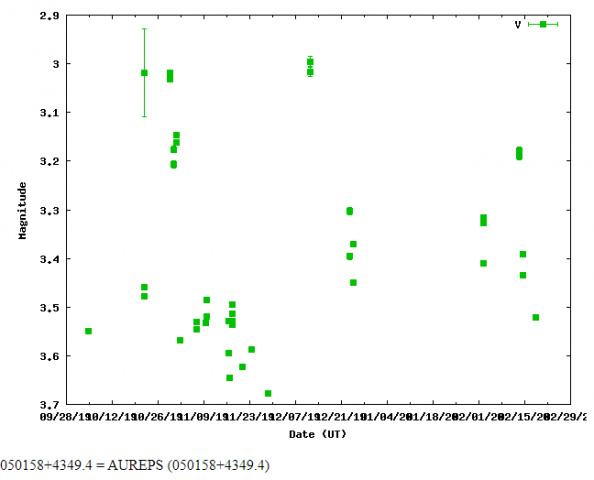Forum Replies Created
-
AuthorPosts
-
13 April 2020 at 4:28 pm in reply to: Forum “Last Post” button and new posts getting lost up the thread #582276
 Robin LeadbeaterParticipant
Robin LeadbeaterParticipantAlso if a new reply is added up the thread, the numbering of all posts in the thread below it are all incremented even though they were posted earlier so you cannot reference a post by its number
 Robin LeadbeaterParticipant
Robin LeadbeaterParticipantHi Hugh,
Nice series !
I tried to merge your spectra with mine as they appeared to show the same trend but ran into difficulties intially. I then compared our spectra on similar dates and saw some differences in the continuum shape (Perhaps due to different technique. To beat down the scintillation I summed multiple short exposures rather than defocus and I used a different reference star HD36777). No matter though as the ratio is consistent so it should be possible to reconcile our two series of spectra and combine them to give full coverage from before minimum
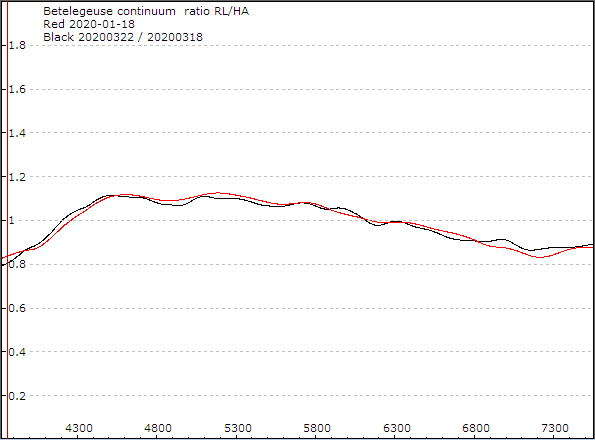
 Robin LeadbeaterParticipant
Robin LeadbeaterParticipantOK so having examined the spectrum images it appears that the uptick in the spectra at the red edge is due to an additional component superimposed over the correct spectrum. This is seen as faint region at the top of the spectrum seen as a lump in the cross sections to the right of the unchanged main cross section profile. See also the attached image.

The origin is unknown. (suggestions welcome) but a working hypothesis (to be tested) is a second order overlap but that is surprising to me at least at this wavelength
Robin
 Robin LeadbeaterParticipant
Robin LeadbeaterParticipantHere are a couple of typical responses for my setup (they differ by less than +-1% and are flat within +-2% . I suspect the dip in the middle is due to slight inaccuracies in the removal of the reference star H alpha profile rather than a real effect. (The graph is 1360 wide compared with the camera 1391 so just 31 pixels trimmed off somewhere)

Cheers
Robin
 Robin LeadbeaterParticipant
Robin LeadbeaterParticipant“I would have thought that, as long as it’s clear what you do (I uncheck the IR box on the dbase entry, and insert appropriate comments in the header) its OK to use an uncorrected spectrum?”
I think we first need to find out why your instrument response is not consistent and independent of the reference star, which it should be if nothing is changing. Otherwise you could be seeing similar variations in your target spectra.
Once that is sorted you can chose not to make an instrument response correction but in my view the spectrum should then be rectified and the flag set in the header rather than post a non calibrated spectrum, otherwise you leave the lamp spectrum imprinted on the continuum
Cheers
Robin
 Robin LeadbeaterParticipant
Robin LeadbeaterParticipantMy LHIRES H alpha spectra are not normally cropped (well perhaps a few Angstroms at the very edge) but my camera might be narrower than yours (an ATIK 314) so perhaps yours is wider and you have some vignetting after the grating, though the flat should still take care of that
Robin
 Robin LeadbeaterParticipant
Robin LeadbeaterParticipantHi Kevin,
changes in atmospheric dispersion chromatic aberrations are unlikely to be the cause over such a narrow range in the red. I have certainly never seen any effects as great as this with my LHIRES. Provided you are doing a flat correction, moving the mirror should just move the spectrum up and down, and perhaps alter its brightness due to vignetting but not alter its shape. The instrument response should essentially just be the flat lamp spectrum ie for a halogen lamp in this part of the spectrum a very gentle smooth slope. (Even placing the star at a different position along the slit should not be a problem provided a flat correction is done, although it is good practise to place the star in the same position)
Is there anywhere you can upload your raw image set to (eg dropbox etc) and I could take a look ?
Cheers
Robin
 Robin LeadbeaterParticipant
Robin LeadbeaterParticipantCloudy here but I grabbed a frame off an all sky camera (University of Hertfordshire http://observatory.herts.ac.uk/allsky/ ) and compared it with the same date and time a year ago. See attached. A crude comparison but the relative brightness of Megrez looks roughly the same to the camera at least
Cheers
Robin
 Robin LeadbeaterParticipant
Robin LeadbeaterParticipant Robin LeadbeaterParticipant
Robin LeadbeaterParticipantB,V Ic correspond to the band in which the brightness was measured. (The survey instrument uses a CCD camera and wide field lens). V corresponds roughly to what the eye sees Ic is the near infrared. There are small long term average trends from season to season but the variation from day to day/week to week of up to 0.5 magnitudes seen in the V data would be obvious by eye if real. The very tight error bars on the points would suggest they are real but I am somewhat sceptical.
 Robin LeadbeaterParticipant
Robin LeadbeaterParticipantIs the short term variation in KWS V mag real ? eg
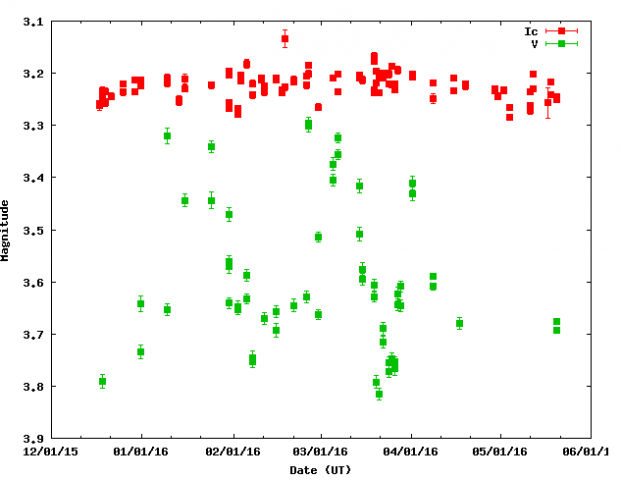
 Robin LeadbeaterParticipant
Robin LeadbeaterParticipantInteresting that the variability in I is much less than in V. Reminiscent of the recent Betelgeuse fading
 Robin LeadbeaterParticipant
Robin LeadbeaterParticipantI was taking spectra last night and the signal from the target suddenly disappeared. I went outside to check and as far as I could tell the sky was completely clear. I went back inside and watched as the signal came back up. Half an hour later the same thing happened but this time I looked outside to find it was foggy, putting an end to observations
 Robin LeadbeaterParticipant
Robin LeadbeaterParticipantI see their spectra stop at 6700A before the larger changes in the spectrum become obvious
 Robin LeadbeaterParticipant
Robin LeadbeaterParticipantI Iooked at this but their claim that the extinction is grey is not the case here if one looks at the photometry in the IR where there was no reduction in H J bands and a smaller drop in R compared with B,V which is also seen in spectra. Perhaps this can be explained by the large grained dust model but I am surprised they have not considered the available photometry data
 Robin LeadbeaterParticipant
Robin LeadbeaterParticipantThe spectrum looks to have returned to how it was at the start of the year
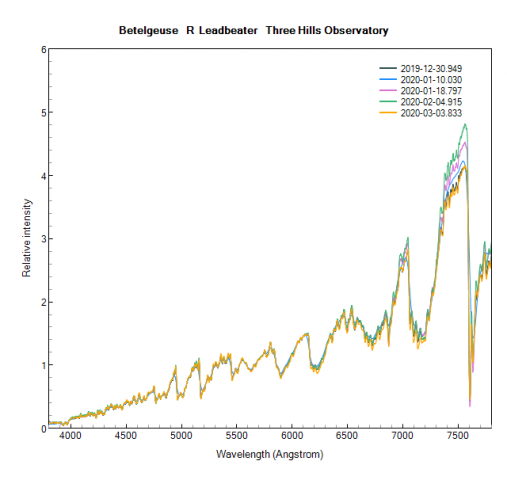
 Robin LeadbeaterParticipant
Robin LeadbeaterParticipantChristian Buil has just posted some high (R ~ 38,000) resolution spectra which confirm the reduction and narrowing of the H alpha line seen in my medium resolution spectra. He also detects a small (4.5km/s) shift in the line.
http://www.spectro-aras.com/forum/viewtopic.php?f=38&t=2433&p=13796#p13792
These observations may be consistent with the partial obscuration of the star as suggested from the VLT images. The speed of rotation of the star is of the right order as can be seen in this reference and the axis of rotation is given there
https://www.obspm.fr/the-slow-rotation-of-the-red.html?lang=eng
As far as I can see, the orientation of the VLT image is not given though unfortunately.
Jeremy, are you still in contact with Prof. Constantino Sigismondi? I wonder if these observations might be of interest
Cheers
Robin
 Robin LeadbeaterParticipant
Robin LeadbeaterParticipantYes slightly as seen in the increased depth of the molecular absorption bands (perhaps 1 subdivision eg M2i to M3i?)
https://britastro.org/comment/7649#comment-7649
https://britastro.org/comment/7861#comment-7861
Interestingly there has also been a reduction in H alpha absorption since the start of the year
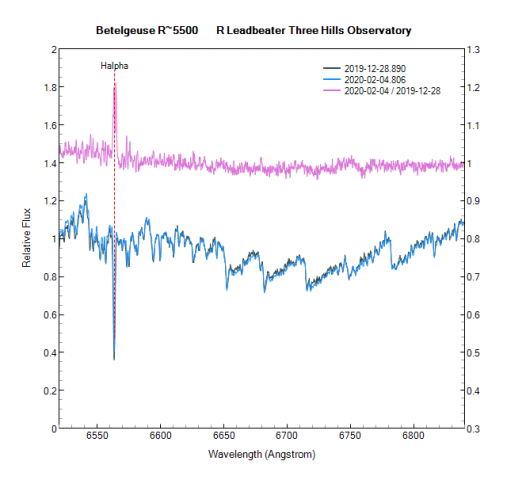
 Robin LeadbeaterParticipant
Robin LeadbeaterParticipantThe plot updated with a spectrum from 2020-02-04 showing continuing evolution in the red
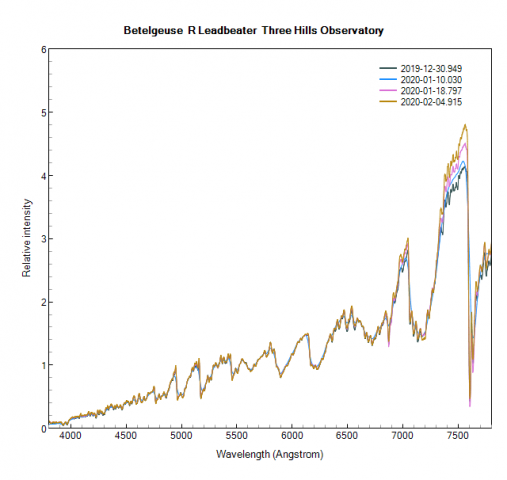
 Robin LeadbeaterParticipant
Robin LeadbeaterParticipantIn this case since it is a particular campaign with specific goals I would probably look to the PI for guidance.
In general though the processing (including combining) of data for submission to databases where the end use is unknown (and in this case potentially may not be known until all of us are long gone) is an ever present dilemma. I faced this in real life for example concerning databases storing vast quantities of process control and quality time series data from a continuous process (a paper machine) where (similar to astronomy) variations over several orders of timescale (from milliseconds to years in that case) are potentially of relevance. Ultimately, storing the data from every exposure and letting the final user make the decision would be ideal (aided perhaps by tools in the database to allow the casual user interrogating the database to view the filtered data). Andy (like our paper mill IT manager at the time) might baulk at every exposure being measured and stored individually indefinitely though! An alternative approach could perhaps be based on examining the data prior to submission to look at what point when combining data the variation if any becomes significant compared to the uncertainty, thus preserving the maximum information while storing the minimum of data.
Cheers
Robin
-
AuthorPosts

